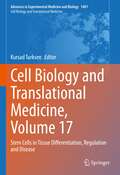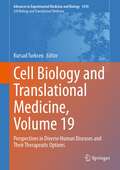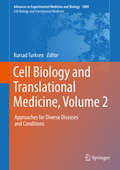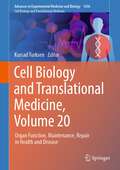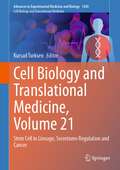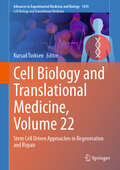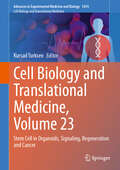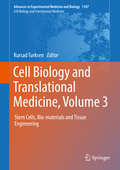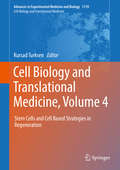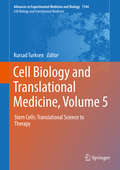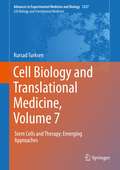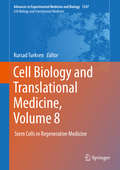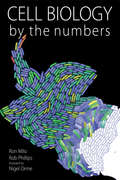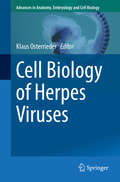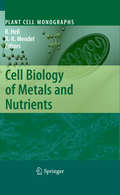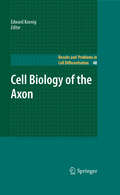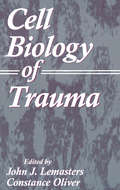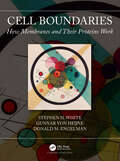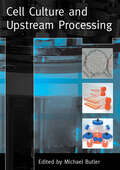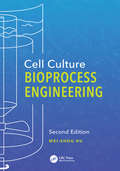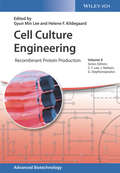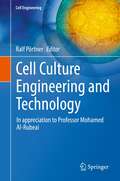- Table View
- List View
Cell Biology and Translational Medicine, Volume 17: Stem Cells in Tissue Differentiation, Regulation and Disease (Advances in Experimental Medicine and Biology #1401)
by Kursad TurksenMuch research has focused on the basic cellular and molecular biological aspects of stem cells. Much of this research has been fueled by their potential for use in regenerative medicine applications, which has in turn spurred growing numbers of translational and clinical studies. However, more work is needed if the potential is to be realized for improvement of the lives and well-being of patients with numerous diseases and conditions.This book series 'Cell Biology and Translational Medicine (CBTMED)' as part of Springer Nature’s longstanding and very successful Advances in Experimental Medicine and Biology book series, has the goal to accelerate advances by timely information exchange. Emerging areas of regenerative medicine and translational aspects of stem cells are covered in each volume. Outstanding researchers are recruited to highlight developments and remaining challenges in both the basic research and clinical arenas. This current book is the 17th volume of a continuing series.
Cell Biology and Translational Medicine, Volume 18: Tissue Differentiation, Repair in Health and Disease (Advances in Experimental Medicine and Biology #1409)
by Kursad TurksenMuch research has focused on the basic cellular and molecular biological aspects of stem cells. Much of this research has been fueled by their potential for use in regenerative medicine applications, which has in turn spurred growing numbers of translational and clinical studies. However, more work is needed if the potential is to be realized for improvement of the lives and well-being of patients with numerous diseases and conditions.This book series 'Cell Biology and Translational Medicine (CBTMED)' as part of Springer Nature’s longstanding and very successful Advances in Experimental Medicine and Biology book series, has the goal to accelerate advances by timely information exchange. Emerging areas of regenerative medicine and translational aspects of stem cells are covered in each volume. Outstanding researchers are recruited to highlight developments and remaining challenges in both the basic research and clinical arenas. This current book is the 18th volume of a continuing series.
Cell Biology and Translational Medicine, Volume 19: Perspectives in Diverse Human Diseases and Their Therapeutic Options (Advances in Experimental Medicine and Biology #1410)
by Kursad TurksenMuch research has focused on the basic cellular and molecular biological aspects of stem cells. Much of this research has been fueled by their potential for use in regenerative medicine applications, which has in turn spurred growing numbers of translational and clinical studies. However, more work is needed if the potential is to be realized for improvement of the lives and well-being of patients with numerous diseases and conditions.This book series 'Cell Biology and Translational Medicine (CBTMED)' as part of Springer Nature’s longstanding and very successful Advances in Experimental Medicine and Biology book series, has the goal to accelerate advances by timely information exchange. Emerging areas of regenerative medicine and translational aspects of stem cells are covered in each volume. Outstanding researchers are recruited to highlight developments and remaining challenges in both the basic research and clinical arenas. This current book is the 19th volume of a continuing series.
Cell Biology and Translational Medicine, Volume 2: Approaches for Diverse Diseases and Conditions (Advances in Experimental Medicine and Biology #1089)
by Kursad TurksenMuch research has focused on the basic cellular and molecular biological aspects of stem cells. Much of this research has been fueled by their potential for use in regenerative medicine applications, which has in turn spurred growing numbers of translational and clinical studies. However, more work is needed if the potential is to be realized for improvement of the lives and well-being of patients with numerous diseases and conditions.This online first book series 'Cell Biology and Translational Medicine (CBTMED)' as part of SpringerNature’s longstanding and very successful Advances in Experimental Medicine and Biology book series, has the goal to accelerate advances by timely information exchange. Emerging areas of regenerative medicine and translational aspects of stem cells are covered in each volume. Outstanding researchers are recruited to highlight developments and remaining challenges in both the basic research and clinical arenas. This current book is the second volume of a continuing series.
Cell Biology and Translational Medicine, Volume 20: Organ Function, Maintenance, Repair in Health and Disease (Advances in Experimental Medicine and Biology #1436)
by Kursad TurksenMuch research has focused on the basic cellular and molecular biological aspects of stem cells. Much of this research has been fueled by their potential for use in regenerative medicine applications, which has in turn spurred growing numbers of translational and clinical studies. However, more work is needed if the potential is to be realized for improvement of the lives and well-being of patients with numerous diseases and conditions.This book series 'Cell Biology and Translational Medicine (CBTMED)' as part of Springer Nature’s longstanding and very successful Advances in Experimental Medicine and Biology book series, has the goal to accelerate advances by timely information exchange. Emerging areas of regenerative medicine and translational aspects of stem cells are covered in each volume. Outstanding researchers are recruited to highlight developments and remaining challenges in both the basic research and clinical arenas. This current book is the 20th volume of a continuing series.
Cell Biology and Translational Medicine, Volume 21: Stem Cell in Lineage, Secretome Regulation and Cancer (Advances in Experimental Medicine and Biology #1450)
by Kursad TurksenMuch research has focused on the basic cellular and molecular biological aspects of stem cells. Much of this research has been fueled by their potential for use in regenerative medicine applications, which has in turn spurred growing numbers of translational and clinical studies. However, more work is needed if the potential is to be realized for improvement of the lives and well-being of patients with numerous diseases and conditions.This book series 'Cell Biology and Translational Medicine (CBTMED)' as part of Springer Nature’s longstanding and very successful Advances in Experimental Medicine and Biology book series, has the goal to accelerate advances by timely information exchange. Emerging areas of regenerative medicine and translational aspects of stem cells are covered in each volume. Outstanding researchers are recruited to highlight developments and remaining challenges in both the basic research and clinical arenas. This current book is the 21stvolume of a continuing series.
Cell Biology and Translational Medicine, Volume 22: Stem Cell Driven Approaches in Regeneration and Repair (Advances in Experimental Medicine and Biology #1470)
by Kursad TurksenIn this next volume in the Cell Biology and Translational Medicine series, we continue to explore the potential utility of stem cells in regenerative medicine. Amongst topics explored in this volume are various aspects of stem cell commitment, differentiation and organogenesis in both health and cancer. Amongst the diverse areas covered are those exploring stems cells in relation to wound healing and their use in treatment of wound healing and different cancers. Other topics include genome editing, regulation of metabolism, immune cells, and algae in medicine. One goal of the series continues to be to highlight timely, often emerging, topics and novel approaches that can accelerate stem cell utility in regenerative medicine.
Cell Biology and Translational Medicine, Volume 23: Stem Cell in Organoids, Signaling, Regeneration and Cancer (Advances in Experimental Medicine and Biology #1474)
by Kursad TurksenIn this new volume in the Cell Biology and Translational Medicine series, we continue to explore the potential utility of stem cells in regenerative medicine. Amongst topics explored in this volume are recent developments in organoids, signaling pathways in regeneration, wound healing, new insights into adipocytes, and regulatory aspects of stem cell commitment, differentiation and organogenesis in both health and disease. One goal of the series continues to be to highlight timely, often emerging, topics and novel approaches that can accelerate stem cell utility in regenerative medicine.
Cell Biology and Translational Medicine, Volume 3: Stem Cells, Bio-materials and Tissue Engineering (Advances in Experimental Medicine and Biology #1107)
by Kursad TurksenMuch research has focused on the basic cellular and molecular biological aspects of stem cells. Much of this research has been fueled by their potential for use in regenerative medicine applications, which has in turn spurred growing numbers of translational and clinical studies. However, more work is needed if the potential is to be realized for improvement of the lives and well-being of patients with numerous diseases and conditions.This book series 'Cell Biology and Translational Medicine (CBTMED)' as part of SpringerNature’s longstanding and very successful Advances in Experimental Medicine and Biology book series, has the goal to accelerate advances by timely information exchange. Emerging areas of regenerative medicine and translational aspects of stem cells are covered in each volume. Outstanding researchers are recruited to highlight developments and remaining challenges in both the basic research and clinical arenas. This current book is the third volume of a continuing series.
Cell Biology and Translational Medicine, Volume 4: Stem Cells and Cell Based Strategies in Regeneration (Advances in Experimental Medicine and Biology #1119)
by Kursad TurksenMuch research has focused on the basic cellular and molecular biological aspects of stem cells. Much of this research has been fueled by their potential for use in regenerative medicine applications, which has in turn spurred growing numbers of translational and clinical studies. However, more work is needed if the potential is to be realized for improvement of the lives and well-being of patients with numerous diseases and conditions. This book series 'Cell Biology and Translational Medicine (CBTMED)' as part of SpringerNature’s longstanding and very successful Advances in Experimental Medicine and Biology book series, has the goal to accelerate advances by timely information exchange. Emerging areas of regenerative medicine and translational aspects of stem cells are covered in each volume. Outstanding researchers are recruited to highlight developments and remaining challenges in both the basic research and clinical arenas. This current book is the fourth volume of a continuing series.
Cell Biology and Translational Medicine, Volume 5: Stem Cells: Translational Science to Therapy (Advances in Experimental Medicine and Biology #1144)
by Kursad TurksenMuch research has focused on the basic cellular and molecular biological aspects of stem cells. Much of this research has been fueled by their potential for use in regenerative medicine applications, which has in turn spurred growing numbers of translational and clinical studies. However, more work is needed if the potential is to be realized for improvement of the lives and well-being of patients with numerous diseases and conditions.This book series 'Cell Biology and Translational Medicine (CBTMED)' as part of SpringerNature’s longstanding and very successful Advances in Experimental Medicine and Biology book series, has the goal to accelerate advances by timely information exchange. Emerging areas of regenerative medicine and translational aspects of stem cells are covered in each volume. Outstanding researchers are recruited to highlight developments and remaining challenges in both the basic research and clinical arenas. This current book is the fifth volume of a continuing series.
Cell Biology and Translational Medicine, Volume 6: Stem Cells: Their Heterogeneity, Niche and Regenerative Potential (Advances in Experimental Medicine and Biology #1212)
by Kursad TurksenMuch research has focused on the basic cellular and molecular biological aspects of stem cells. Much of this research has been fueled by their potential for use in regenerative medicine applications, which has in turn spurred growing numbers of translational and clinical studies. However, more work is needed if the potential is to be realized for improvement of the lives and well-being of patients with numerous diseases and conditions.This book series 'Cell Biology and Translational Medicine (CBTMED)' as part of SpringerNature’s longstanding and very successful Advances in Experimental Medicine and Biology book series, has the goal to accelerate advances by timely information exchange. Emerging areas of regenerative medicine and translational aspects of stem cells are covered in each volume. Outstanding researchers are recruited to highlight developments and remaining challenges in both the basic research and clinical arenas. This current book is the sixth volume of a continuing series.
Cell Biology and Translational Medicine, Volume 7: Stem Cells and Therapy: Emerging Approaches (Advances in Experimental Medicine and Biology #1237)
by Kursad TurksenMuch research has focused on the basic cellular and molecular biological aspects of stem cells. Much of this research has been fueled by their potential for use in regenerative medicine applications, which has in turn spurred growing numbers of translational and clinical studies. However, more work is needed if the potential is to be realized for improvement of the lives and well-being of patients with numerous diseases and conditions.This book series 'Cell Biology and Translational Medicine (CBTMED)' as part of SpringerNature’s longstanding and very successful Advances in Experimental Medicine and Biology book series, has the goal to accelerate advances by timely information exchange. Emerging areas of regenerative medicine and translational aspects of stem cells are covered in each volume. Outstanding researchers are recruited to highlight developments and remaining challenges in both the basic research and clinical arenas. This current book is the seventh volume of a continuing series.
Cell Biology and Translational Medicine, Volume 8: Stem Cells in Regenerative Medicine (Advances in Experimental Medicine and Biology #1247)
by Kursad TurksenMuch research has focused on the basic cellular and molecular biological aspects of stem cells. Much of this research has been fueled by their potential for use in regenerative medicine applications, which has in turn spurred growing numbers of translational and clinical studies. However, more work is needed if the potential is to be realized for improvement of the lives and well-being of patients with numerous diseases and conditions.This book series 'Cell Biology and Translational Medicine (CBTMED)' as part of SpringerNature’s longstanding and very successful Advances in Experimental Medicine and Biology book series, has the goal to accelerate advances by timely information exchange. Emerging areas of regenerative medicine and translational aspects of stem cells are covered in each volume. Outstanding researchers are recruited to highlight developments and remaining challenges in both the basic research and clinical arenas. This current book is the eight volume of a continuing series.
Cell Biology by the Numbers
by Ron Milo Rob PhillipsA Top 25 CHOICE 2016 Title, and recipient of the CHOICE Outstanding Academic Title (OAT) Award. How much energy is released in ATP hydrolysis? How many mRNAs are in a cell? How genetically similar are two random people? What is faster, transcription or translation?Cell Biology by the Numbers explores these questions and dozens of others provid
Cell Biology of Herpes Viruses (Advances in Anatomy, Embryology and Cell Biology #223)
by Klaus OsterriederHerpes viruses are widely distributed in nature, causing disease in organisms as diverse as bivalves and primates, including humans. Each virus appears to have established a long-standing relationship with its host, and the viruses have the ability to manipulate and control the metabolism of host cells, as well as innate and adaptive antiviral immune responses. Herpes viruses maintain themselves within hosts in a latent state resulting in virus persistence for years - usually for the life span of the hosts. Herpes viruses comprise a large number of pathogens with diverse cellular targets and biological consequences of infection. What they have in common is their structure and the fact that they establish a dormant (latent) infection in their hosts that usually persists for life. The reviews here will highlight the general principles of herpes virus infection, with equal attention to overall principle and important difference. Also, the cell type- and life-style dependent differences in the establishment and maintenance of virus persistence will be covered.
Cell Biology of Metals and Nutrients (Plant Cell Monographs #17)
by Ralf-Rainer Mendel Rüdiger HellPlants are composed of 17 essential and at least 5 beneficial elements, and these must be taken up as metal or nutrient ions to allow for growth and cell division. Much effort has been devoted to studying the physiology and biochemistry of metals and nutrients in plants. The aspect of cell biology, however, is an emerging new field and much needs to be learned about sensing, long-distance communication within plants, and cellular signal transduction chains in response to environmental stress. Cellular malfunction and consequently disease result when any of the key steps in metal and nutrient homeostasis are disrupted. Working together, leading experts in their respective fields provide a new concept that reaches beyond plant nutrition and plasmalemma transport into cellular physiology. Each chapter contains basic information on uptake, physiological function, deficiency and toxicity syndromes, long-distance and intracellular transport. The discussion is devoted to metals and nutrients where recent progress has been made and highlights the aspects of homeostasis and sensing, signaling and regulation, drawing parallels to other organisms including humans. Finally, the book identifies gaps in our current knowledge and lays out future research directions.
Cell Biology of the Axon (Results and Problems in Cell Differentiation #48)
by Edward KoenigRecent years have witnessed striking advances in research on axons at a cellular level that substantially impact our current understanding of axonal biology. Newer findings and their ramifications are critically reviewed in the 16 chapters of this volume by authors highly qualified by virtue of their scientific contributions to research areas they know and write about. Five basic areas (I to V) germane to axonal biology are highlighted, beginning with (I) signaling interactions mediating myelination, and differentiation of axonal membrane domains; (IIa) issues surrounding organization and transport dynamics of neurofilaments in axons, (IIb) mechanisms regulating microtubule organization and dynamics, misregulation of which causes axonal degeneration, and (IIc) the roles actin binding proteins play in regulating organization and functions of the actin filament system in mature and growing axons; (IIIa) myosin motor proteins and cargoes intrinsic to the axon compartment, (IIIb) mitochondrial transport motors, and imperatives governing transport dynamics and directional delivery, (IIIc) mechanisms mediating retrograde signaling associated with NGF's role in trophic-dependent neuronal survival, and (IIId) potential for impaired subcellular targeting of a -synuclein as a mechanism for accumulation of Lewy body inclusions in synucleinopathies; (IVa) occurrence and organization of discrete ribosome-containing domains in axons, (IVb) endogenous mRNAs, classes of proteins translated locally, and RNP trafficking in axons, (IVc) importance of locally synthesized nuclear encoded mitochondrial proteins for maintenance, function and survival of axons, (IVd) occurrence of RNA trafficking from glial cells to axons, and significance glial RNA transcripts may play in expression in axons and axon terminals, (IVe) RNA trafficking and localization of RNA transcripts in axonal growth cones, and signaling pathways that modulate local protein synthesis for directional elongation, and (IVf) genetic and molecular defects underlying spinal muscular atrophy, and roles that SMN gene product plays as a molecular chaperone in mRNA transport and translation; (Va) injury-induced local synthesis of a protein forming a retrograde signaling complex in axons to stimulate regeneration, and (Vb) endogenous and exogenous factors that condition axonal regenerative capacity in PNS and CNS, including injury-induced activation of specific genes governing regeneration. Emergent complexities revealed in this volume compel a major revision in the traditional conceptual model of the axon's intrinsic makeup and capacities.
Cell Biology of Trauma
by Constance Oliver John J. LemastersThis unique book presents an approach to viewing trauma. It examines the cellular consequences of trauma at a molecular level and provides new insights into the treatment of traumatic injury, based on cellular responses. The current of trauma research is reviewed, previously unpublished information on the topic is presented, and research directions are included.
Cell Boundaries: How Membranes and Their Proteins Work
by Stephen H White Gunnar von Heijne Donald M EngelmanThe central themes of Cell Boundaries concern the structural and organizational principles underlying cell membranes, and how these principles enable function. By building a biological and biophysical foundation for understanding the organization of lipids in bilayers and the folding, assembly, stability, and function of membrane proteins, the book aims to broaden the knowledge of bioscience students to include the basic physics and physical chemistry that inform us about membranes. In doing so, it is hoped that physics students will find familiar territory that will lead them to an interest in biology. Our progress toward understanding membranes and membrane proteins depends strongly upon the concerted use of both biology and physics. It is important for students to know not only what we know, but how we have come to know it, so Cell Boundaries endeavours to bring out the history behind the central discoveries, especially in the early chapters, where the foundation is laid for later chapters. Science is far more interesting if, as students, we can appreciate and share in the adventures—and misadventures—of discovering new scientific knowledge. Cell Boundaries was written with advanced undergraduates and beginning graduate students in the biological and physical sciences in mind, though this textbook will likely have appeal to researchers and other academics as well. Highlights the history of important central discoveries Early chapters lay the foundation for later chapters to build on, so knowledge is amassed High-quality line diagrams illustrate key concepts and illuminate molecular mechanisms Box features and spreads expand on topics in main text, including histories of discoveries, special techniques, and applications
Cell-Cell Interactions: Methods and Protocols (Methods in Molecular Biology #1066)
by Troy A. BaudinoIn the second edition of Cell-Cell Interactions: Methods and Protocols, expert researchers in the field detail a collection of protocols to examine interactions between cells. These include protocols that focus on both in vivo and in vitro methods-based approaches. New updated chapters also bring together many currently used assays in examining cell-cell interactions and the biological consequences of those interactions. Written in the highly successful Methods in Molecular Biology series format, chapters include introductions to their respective topics, lists of the necessary materials and reagents, step-by-step, readily reproducible laboratory protocols, and key tips on troubleshooting and avoiding known pitfalls. Authoritative and Practical, Cell-Cell Interactions: Methods and Protocol, Second Edition is a valuable resource for researchers who are already involved in the cell-cell interaction field, and also for those that are new to the area.
Cell Culture and Upstream Processing
by Michael ButlerUpstream processing refers to the production of proteins by cells genetically engineered to contain the human gene which will express the protein of interest. The demand for large quantities of specific proteins is increasing the pressure to boost cell culture productivity, and optimizing bioreactor output has become a primary concern for most pharmaceutical companies. Each chapter in Cell Culture and Upstream Processing is taken from presentations at the highly acclaimed IBC conferences as well as meetings of the European Society for Animal Cell Technology (ESACT) and Protein Expression in Animal Cells (PEACe) and describes how to improve yield and optimize the cell culture production process for biopharmaceuticals, by focusing on safety, quality, economics and operability and productivity issues. Cell Culture and Upstream Processing will appeal to a wide scientific audience, both professional practitioners of animal cell technology as well as students of biochemical engineering or biotechnology in graduate or high level undergraduate courses at university.
Cell Culture Bioprocess Engineering, Second Edition
by Wei-Shou HuThis book is the culmination of three decades of accumulated experience in teaching biotechnology professionals. It distills the fundamental principles and essential knowledge of cell culture processes from across many different disciplines and presents them in a series of easy-to-follow, comprehensive chapters. Practicality, including technological advances and best practices, is emphasized. This second edition consists of major updates to all relevant topics contained within this work. The previous edition has been successfully used in training courses on cell culture bioprocessing over the past seven years. The format of the book is well-suited to fast-paced learning, such as is found in the intensive short course, since the key take-home messages are prominently highlighted in panels. The book is also well-suited to act as a reference guide for experienced industrial practitioners of mammalian cell cultivation for the production of biologics.
Cell Culture Engineering: Recombinant Protein Production (Advanced Biotechnology)
by Sang Yup Lee Jens Nielsen Gregory StephanopoulosOffers a comprehensive overview of cell culture engineering, providing insight into cell engineering, systems biology approaches and processing technology In Cell Culture Engineering: Recombinant Protein Production, editors Gyun Min Lee and Helene Faustrup Kildegaard assemble top class authors to present expert coverage of topics such as: cell line development for therapeutic protein production; development of a transient gene expression upstream platform; and CHO synthetic biology. They provide readers with everything they need to know about enhancing product and bioprocess attributes using genome-scale models of CHO metabolism; omics data and mammalian systems biotechnology; perfusion culture; and much more. This all-new, up-to-date reference covers all of the important aspects of cell culture engineering, including cell engineering, system biology approaches, and processing technology. It describes the challenges in cell line development and cell engineering, e.g. via gene editing tools like CRISPR/Cas9 and with the aim to engineer glycosylation patterns. Furthermore, it gives an overview about synthetic biology approaches applied to cell culture engineering and elaborates the use of CHO cells as common cell line for protein production. In addition, the book discusses the most important aspects of production processes, including cell culture media, batch, fed-batch, and perfusion processes as well as process analytical technology, quality by design, and scale down models. -Covers key elements of cell culture engineering applied to the production of recombinant proteins for therapeutic use -Focuses on mammalian and animal cells to help highlight synthetic and systems biology approaches to cell culture engineering, exemplified by the widely used CHO cell line -Part of the renowned "Advanced Biotechnology" book series Cell Culture Engineering: Recombinant Protein Production will appeal to biotechnologists, bioengineers, life scientists, chemical engineers, and PhD students in the life sciences.
Cell Culture Engineering and Technology: In appreciation to Professor Mohamed Al-Rubeai (Cell Engineering #10)
by Ralf PörtnerThis contributed volume is dedicated towards the progress achieved within the last years in all areas of Cell Culture Engineering and Technology. It comprises contributions of active researchers in the field of cell culture development for the production of recombinant proteins, cell line development, cell therapy and gene therapy, with consideration of media development, process scale-up, reactor design, monitoring and control and model-assisted strategies for process design. The knowledge and expertise of the authors cover disciplines like cell biology, engineering, biotechnology and biomedical sciences. This book is conceived for graduate students, postdoctoral fellows and researchers interested in the latest developments in Cell Engineering.
